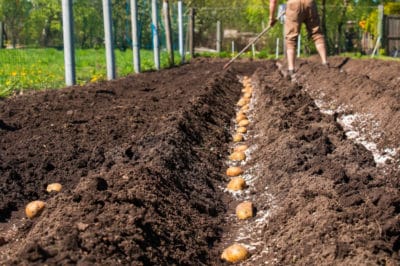Growing Basics
No matter when you plant your potatoes, they have the same requirements. First, potatoes require very fertile soil since they are heavy feeders. Second, the soil must drain well to prevent rot. Third, the soil must be loose, friable and rock free to allow for tuber development. Fourth, potatoes must have adequate water while they are actively growing.
Advantages of Fall Planting
If your climate allows it, fall planting can have a number of benefits. Among them:
- Space in the garden is freed up for late spring crops.
- Fall is often not as busy a time in the garden.
- The Colorado potato beetle – a serious pest – burrows underground once temperatures cool off.
- Potatoes develop a strong root system.
Growing Potatoes in the Desert
Potatoes don’t like hot temperatures. They will not grow as well, may not flower or flower too early, and the tubers may not develop properly. They must have full sun, but the desert sun in summer creates too much heat. For all of these reasons, desert gardeners find it usually works better to plant potatoes in fall for winter growth. In all other respects, the care and harvesting is the same.
Southern Gardeners
If you live in one of the southern states, you might consider early fall planting for your potato crop. Even with a maturity date of 100 to 120 days – the range for a mid-season potato – you’ll probably be able to harvest a crop before winter really hits. As long as the ground doesn’t freeze hard, once the vines start to die down, your potato tubers can weather a few frosts.
An Early Start
If you garden in an area where the ground doesn’t freeze deeply – say up to about USDA Zone 5 – fall planting can be a good way to get your potatoes up and growing early in the spring. The tubers can develop roots over the winter, and once spring hits, they put all their energy into vegetative growth. However, you must be careful not to allow the tubers to sit in water-logged soil – use raised beds if necessary.
Fall Planting Compost System
Trench mulching is a way to plant potatoes in fall in cold areas and take advantage of the warmth generated by the decaying mulch. Till the ground and dig a trench about eight inches deep. Put 4 or 5 inches of leaves or pine needles in the trench. Plant whole small seed potatoes – not cut up chunks of larger potatoes – on top and cover to ground level with soil.
